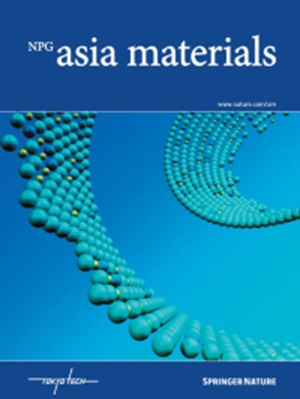用于自供电偏振敏感光电探测的本征各向异性 1D NbTe4
IF 8.3
2区 材料科学
Q1 MATERIALS SCIENCE, MULTIDISCIPLINARY
引用次数: 0
摘要
偏振敏感的光探测增强了场景信息捕获,这对现代光电设备至关重要。具有本征各向异性的一维(1D)材料能够直接感知偏振光,有望成为这种光电探测器。NbTe4是一种准一维过渡金属四硫族化合物,由于其结构的各向异性,在偏振敏感光探测中具有显著的优势。然而,迄今为止,1D NbTe4的各向异性尚未被报道。本文以针状块状晶体为原料,采用机械剥离法制备了NbTe4纳米带,并对其各向异性和光电子性能进行了全面研究。角分辨偏振拉曼光谱,结合方位角依赖反射差显微镜,证实了1D NbTe₄具有固有的结构和平面内光学各向异性。1D NbTe4器件表现出了特征的各向异性光探测行为,在671 nm和1064 nm处实现了1.16和1.25的二向色比。同时,该器件表现出明显的光热电效应,具有从可见光到近红外波长(532-1064 nm)的广谱光响应,快速响应时间为158 ms。这项研究表明,NbTe4固有地具有面内各向异性,使其成为偏振敏感光探测应用的有希望的候选者。一维过渡金属四硫族化合物NbTe4具有固有的结构和光学各向异性,已被用于开发偏光敏感的光电探测器。基于NbTe4薄片的器件显示出明显的各向异性光探测特性,在671nm和1064nm处的二向色比分别为1.16和1.25。它还展示了一个显著的光热电效应,实现了从可见到近红外光谱(532-1064 nm)的广谱响应。本文章由计算机程序翻译,如有差异,请以英文原文为准。

Intrinsically anisotropic 1D NbTe4 for self-powered polarization-sensitive photodetection
Polarization-sensitive photodetection enhances scene information capture, crucial for modern optoelectronic devices. One-dimensional (1D) materials with intrinsic anisotropy, capable of directly sensing polarized light, are promising for such photodetectors. NbTe4, a quasi-1D transition metal tetra-chalcogenide, offers significant benefits for polarization-sensitive photodetection due to its structural anisotropy. Nonetheless, to date, the anisotropic properties of 1D NbTe4 have not been reported. Herein, NbTe4 nanobelts were synthesized via mechanical exfoliation from needle-like bulk crystals, and their anisotropic and optoelectronic properties were comprehensively studied. Angle-resolved polarized Raman spectroscopy, in conjunction with azimuth-dependent reflectance difference microscopy, confirmed that 1D NbTe₄ exhibits intrinsic structural and in-plane optical anisotropy. The 1D NbTe4 device demonstrated characteristic anisotropic photodetection behavior, achieving dichroic ratios of 1.16 at 671 nm and 1.25 at 1064 nm. Meanwhile, the device exhibits a pronounced photothermoelectric effect, conferring a broad spectral photoresponse ranging from visible to near-infrared wavelengths (532-1064 nm), with a rapid response time of 158 ms. This study demonstrates that NbTe4 inherently possesses in-plane anisotropy, making it a promising candidate for polarization-sensitive photodetection applications. The 1D transition metal tetra-chalcogenides, NbTe4, with inherent structural and optical anisotropy, has been used to develop a polarization-sensitive photodetector. The NbTe4 flakes-based device displays pronounced anisotropic photodetection properties with a dichroic ratio of 1.16 at 671 nm and 1.25 at 1064 nm. It also demonstrates a significant photothermoelectric effect, enabling a broad spectral response from the visible to near-infrared spectrum (532-1064 nm).
求助全文
通过发布文献求助,成功后即可免费获取论文全文。
去求助
来源期刊

Npg Asia Materials
MATERIALS SCIENCE, MULTIDISCIPLINARY-
CiteScore
15.40
自引率
1.00%
发文量
87
审稿时长
2 months
期刊介绍:
NPG Asia Materials is an open access, international journal that publishes peer-reviewed review and primary research articles in the field of materials sciences. The journal has a global outlook and reach, with a base in the Asia-Pacific region to reflect the significant and growing output of materials research from this area. The target audience for NPG Asia Materials is scientists and researchers involved in materials research, covering a wide range of disciplines including physical and chemical sciences, biotechnology, and nanotechnology. The journal particularly welcomes high-quality articles from rapidly advancing areas that bridge the gap between materials science and engineering, as well as the classical disciplines of physics, chemistry, and biology. NPG Asia Materials is abstracted/indexed in Journal Citation Reports/Science Edition Web of Knowledge, Google Scholar, Chemical Abstract Services, Scopus, Ulrichsweb (ProQuest), and Scirus.
 求助内容:
求助内容: 应助结果提醒方式:
应助结果提醒方式:


